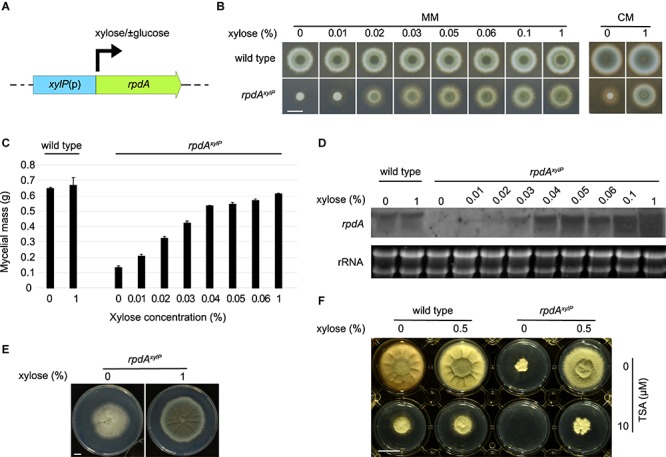FIGURE 1.

Expression of rpdA is tunable by xylose in strain rpdAxylP during axenic growth. (A) Scheme of rpdA expression under control of the xylP promoter, xylP(p), in strain rpdAxylP. The arrow indicates strong induction by xylose even in the presence of glucose. The transcription start sites (34 and 38 bp upstream of the translation start) have been determined previously (Haas et al., 1993). Promoter motifs including putative binding sites for the xylose-sensing transcription factor XlnR have been predicted previously (Zadra et al., 2000). (B) Growth of rpdAxylP and wild type on solid minimal (MM) and complex (CM) media with different xylose concentrations. Fungal strains were point inoculated (1 × 104 conidia), pictures were taken after incubation for 48 h at 37°C. (C) Biomass measurements of rpdAxylP mycelia grown in liquid minimal medium. Media were inoculated with 106 conidia per ml and biomass production was determined after growth for 24 h at 37°C. Error bars represent the standard deviation of three replicates. (D) Northern analysis of rpdA expression in wild type and rpdAxylP grown under different xylose concentrations. RNA was isolated after 20 h of growth in liquid minimal medium supplemented with xylose as indicated. (E) Growth of rpdAxylP on solid MM with and without xylose. Fungal strains were point inoculated (1 × 104 conidia), pictures were taken after incubation for 5 days at 37°C. (F) Effect of trichostatin A (TSA) on growth of wild type and rpdAxylP with and without xylose induction. Fungal strains were point inoculated (1 × 104 conidia) on solid MM containing 10 μM TSA solubilized in DMSO or the same DMSO concentration (0.2%) without TSA. Picture was taken after 3 days of incubation at 37°C. Scale bars represent 1 cm.
